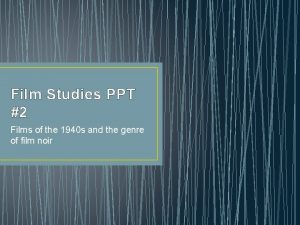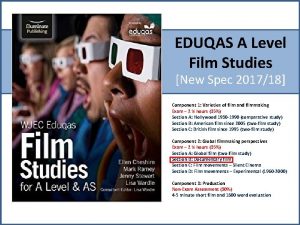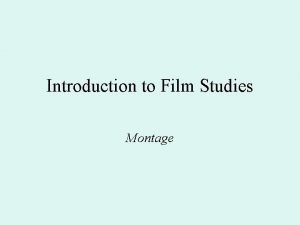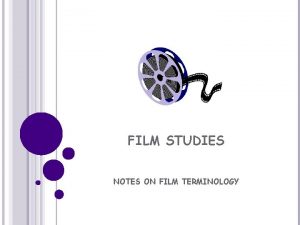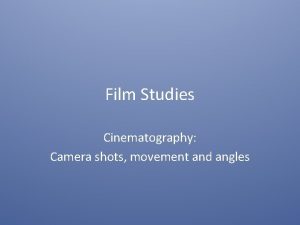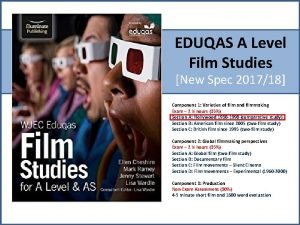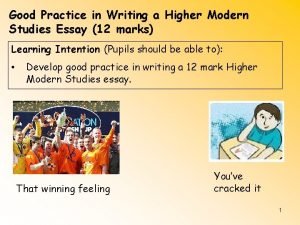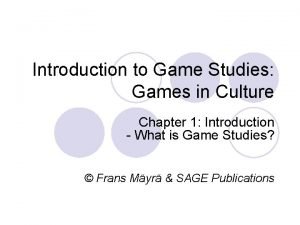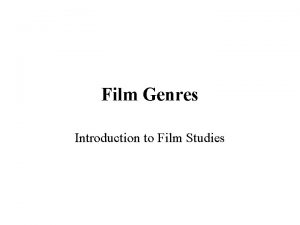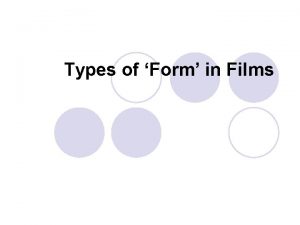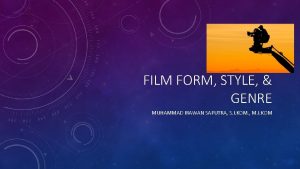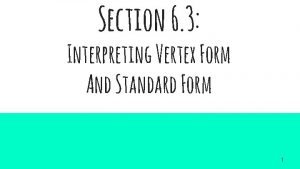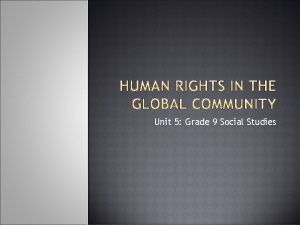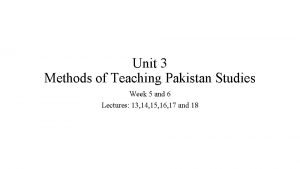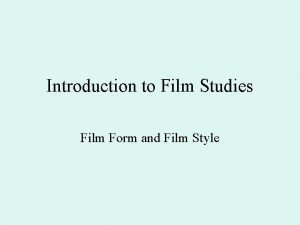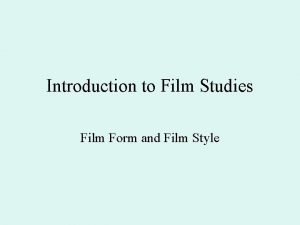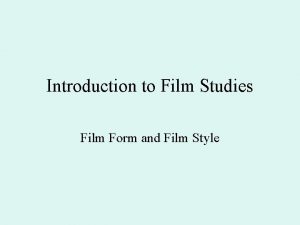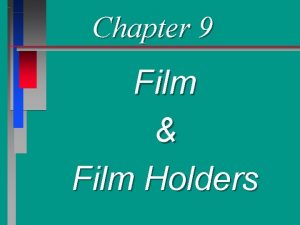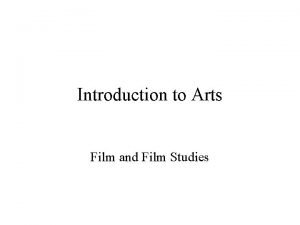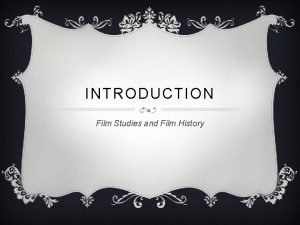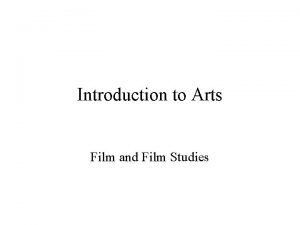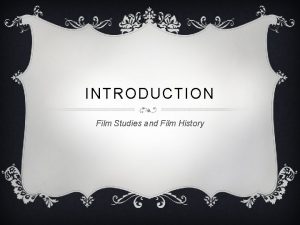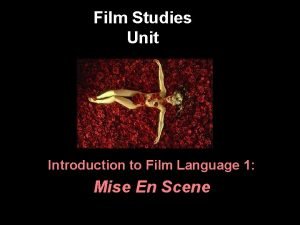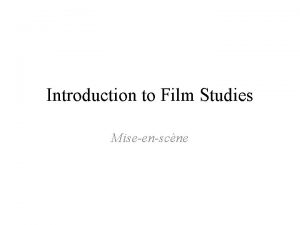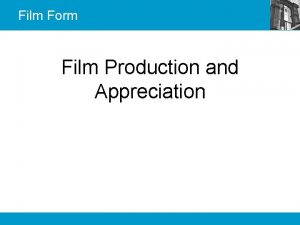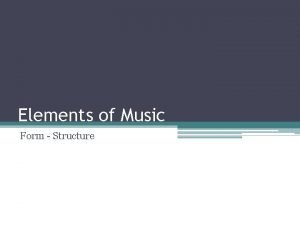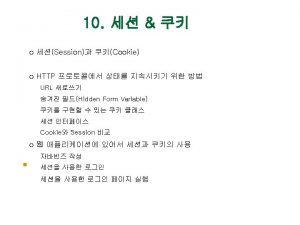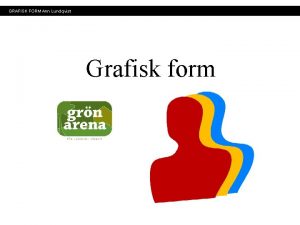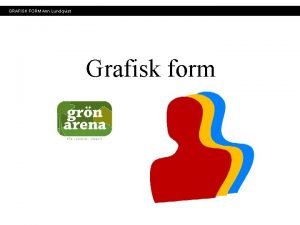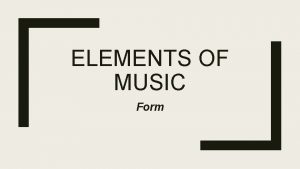Introduction to Film Studies Film Form and Film

























- Slides: 25

Introduction to Film Studies Film Form and Film Style

Openings and Endings • A narrative starts from its very beginning – ab obo or ab initio • Casablanca begins with an introduction in which the film’s backgrounds are explained away. • Alfred Hitchcock’s Stranger on a Train (1951) Tennis star Guy Haines meets Bruno Anthony, a stranger on a train. Knowing from a gossip magazine that Guy wants to divorce from his wife, Bruno proposes the perfect ‘criss-cross’ murders. Strangers on a Train Part II

Openings and Endings • Medias-res - an artistic and literary technique of relating a story from a midpoint rather than the beginning. • Edward Dmytryk’s Crossfire (1947) is about the murder of a man in his girlfriend apartment in Washington DC. A homicide captain discovers evidence that one or more demobilized soldiers are involved in his death. The film begins with the murdering and then shows the events leading up to the killing. Medias-res • Crossfire

Openings and Endings • Another typical example of medias-res found in Francis Ford Coppola’s Godfather (1972) • It is about the conflicts and continuing fighting between New York Mafia families, and the death of a godfather and the rise of a younger one. The story begins as Don Vito Corleone, the head of a New York Mafia family, oversees his daughter’s wedding. He is consulting an Italian. American who wants help from the godfather.

Openings and Endings • Closed ending - narrative ends with an unequivocal conclusion Casablanca • Open ending - narrative ends without clear conclusion and solution so that the reader or the viewer wonder what will happen after the end of the stories. • François Truffaut’s 400 Blows (Quatre cent coups, 1959) • A teenage boy misunderstood at home and school, commits a minor crime and is sent to an observation centre for the juvenile delinquent. He escapes from it while playing football.

Narrative Analysis • Five foci in the narrative analysis of Gérard Genette’s Narratology. Narrative Discourse: An Essay in Method (1980) • Order, frequency, duration, voice and mood • Order: an order of event units being told • Chronological order: telling events following one after another in time; from the oldest to the most recent event • (a) crime conceived (b) crime planned (c)crime committed (d) crime discovered (e) detective investigates (f) detective reveals

Narrative Analysis: Chronological Story-telling 1 • (a) Crime conceived • (b) Crime planned 2 • (c) Crime committed • (d) Crime discovered 3 • (e) Detective investigates • (f) Detective reveals who’s done it.

Narrative Analysis: Non-chronological Story-telling • Narration out of chronological order • Order of telling events is manipulated according to the logic other than chronological • Telling older events later is called ‘flashback’

Narrative Analysis: Chronological Story-telling 2 -3 • (d) Crime discovered • (e) Detective investigates 3 -1 • (f) Detective reveals who’s done it • (a) Crime conceived 1 -2 • (b) Crime planned • (c) Crime committed

Order Distant Lives • Most of the stories in Citizen Kane are flashbacks. • In Terence Davies’s Distant Voices, Still Lives, we see scenes set in the present during a young woman’s wedding day. These alternate with flashbacks to a time when her family lived under the sway of an abusive, mentally disturbed father.

Order • Flashforward – a scene that takes the narrative forward in time from the current time of the plot • Nichola Roeg’s Don’t Look Now • A man sees his wife in black on a boat, though she is supposed to be away. At the end of the film, it is revealed that she is with her husband’s coffin.

Frequency • An event can occur once and be narrated once (singular) Today I went to the bar. • An event can occur n times and be narrated once (iterative) I used to go to the bar. • An event can occur once and be narrated n times (repetitive) I went to the bar. Different people saw me going to the bar. • An event can occur n times and be narrated n times (multiple) I used to go to the bar and other people saw me going to the bar a number of times.

Frequency • Peter Howitt’s Sliding Doors (1998) – a young woman gets fired from her public relations job. After she heads for a London Underground station, the plot splits into two: one in which she catches the train, the other in which misses it.

Duration • Difference between discourse time and narrative time • Discourse time – time spent to narrate the event Narrative time – real time that has passed for an event to take place • ‘ 5 years later’ a lengthy narrative time, but it could be a matter of second in discourse time

Duration • Narrative time is normally shorter than discourse time • Several million years are covered in Space Odyssey by 161 minutes • Kane’s life covered in Citizen Kane in 119 mins. • Many years covered in Amadeus by 138 minutes • Four days covered in North by Northwest by 136 minutes • One day covered in Hiroshima, mon amour by 90 minutes

Duration • Elipsis: the omission of a large section of a narrative • Ozu Yasujiro’s Tokyo Story - the scene of mother lying in coma cut to the morning scene, in which she is already passed away.

Duration • In some films discourse time, plot time last as long as narrative time or real time. • Andy Warhol’s Empire (1964) • Cezare Zavattini’s experimental omnibus film, Love in the City (1953) Tre ore di paradiso

Duration • In the 1964 Tokyo Olympic Games, Abebe Bikila won the gold medal in marathon, with 2 hours 12 minutes and 11 seconds (narrative time) but Kon Ichikdawa showed the race in about 8 minutes (discourse time). Tokyo Olympiad (1965) marathon

Duration • Rarely discourse time is longer than narrative time • Bob Hayes won the 100 meter with 10. 00 seconds but the race is shown in 30 seconds • Tokyo Olympiade

Voice • Voice is connected with who narrates and from where • Where the narration is from: Intra-diegetic: inside the text (narrated from the film narrative) Extra-diegetic: outside the text (narrated from outside film narrative)

Voice • Who narrates: Hetero-diegetic: the narrator is not a character in a film Homo-diegetic: the narrator is a character in a film • First person narrating and third person narrating • http: //www. slideshare. net/etaylorchs/narrative 5566418

Voice • Intra-diegetic, homo-diegetic first person narrating • David Lean’s Brief Encounter (1945) – a housewife who is having an affair with a married doctor whom she met in a station is narrating what is going on inside herself. Rachmaninov’s music as a extra-diegetic element.

Voice • Extra-diegetic, hetero-diegetic third person narrating: the speaker speaks from outside the story never using ‘I’ • Stanley Kubrick’s Barry Lyndon is narrated by Michael Hordern

Mood • Mood – the various degree of ‘distance’ created between the narrator of a film and what she narrates. • Distance helps the viewer to determine the degree of precision in a narrative and the accuracy of information conveyed. • Unreliable narrator: the distance between a narrator and what he narrates is wide: • The narrator in Citizen Kane – a journalist gathering information about who Kane really is and what ‘rose bud’ really means.

Mood Lady in the Lake • First-person perspective – the camera become the viewpoint of the film as well as a character • Robert Montgomery’s ambition to create a cinematic version of the first-person narrative of Raymond Chandler in Lady in the Lake (1947)
 Film studies ppt
Film studies ppt Paradigm shift from women studies to gender studies
Paradigm shift from women studies to gender studies Film studies a level eduqas
Film studies a level eduqas Montage in film studies
Montage in film studies Film studies terminology
Film studies terminology Cantered angle
Cantered angle A level film studies past papers
A level film studies past papers Wedge film journal bearing
Wedge film journal bearing Negative form present continuous
Negative form present continuous Cultural studies
Cultural studies Higher modern studies essay questions
Higher modern studies essay questions Higher modern studies 12 mark essay examples
Higher modern studies 12 mark essay examples Weather studies introduction to atmospheric science
Weather studies introduction to atmospheric science American meteorological society
American meteorological society An introduction to game studies
An introduction to game studies Movie genres and subgenres
Movie genres and subgenres Categorical documentary
Categorical documentary Film form adalah
Film form adalah Faraday's law integral form
Faraday's law integral form Vertex form and standard form
Vertex form and standard form Affirmative long form
Affirmative long form Simplex standard form
Simplex standard form Body paragraph structure
Body paragraph structure Vce outdoor education study design
Vce outdoor education study design History grade 9 unit 5
History grade 9 unit 5 Methods of teaching pakistan studies
Methods of teaching pakistan studies
